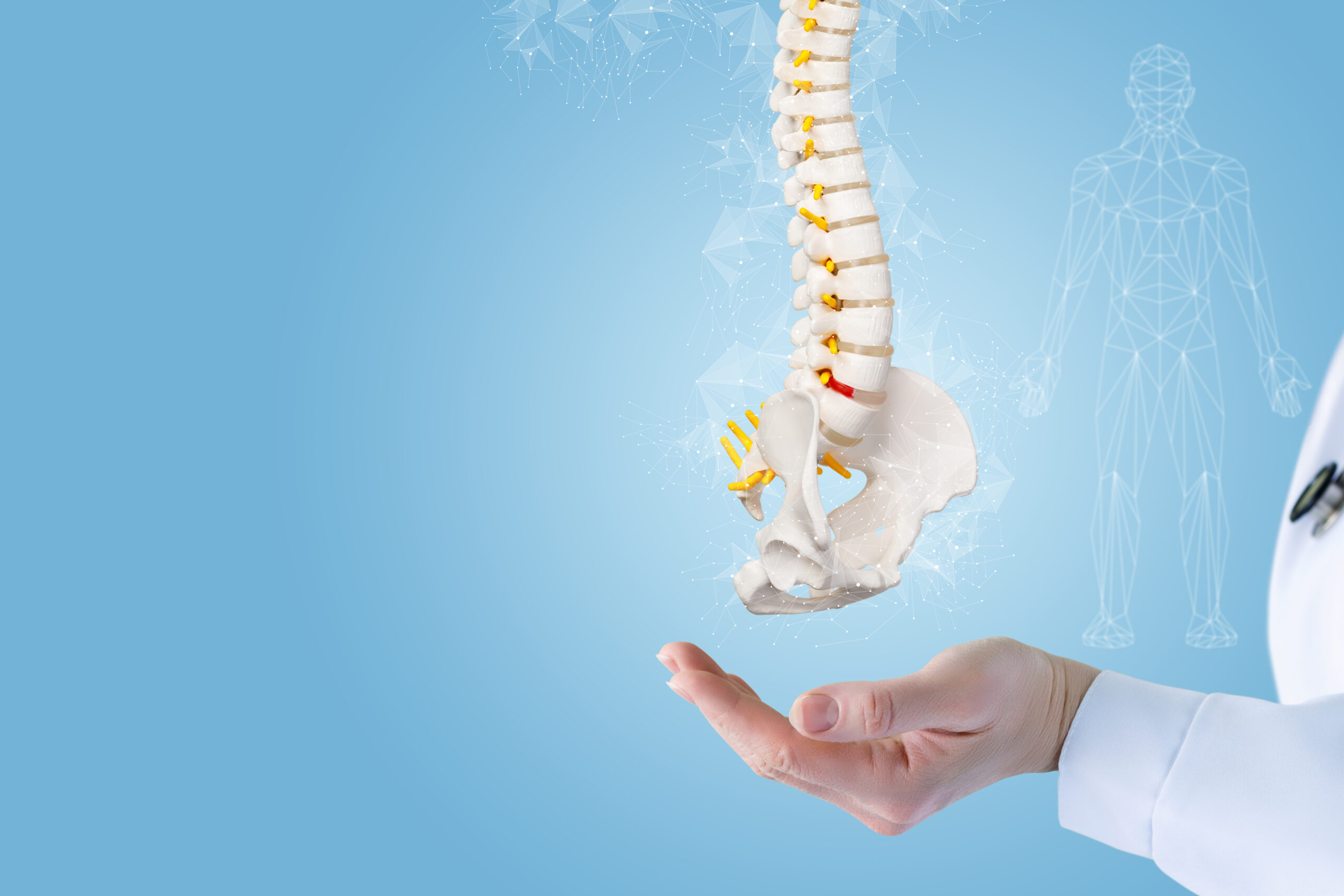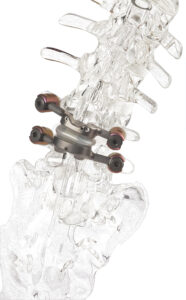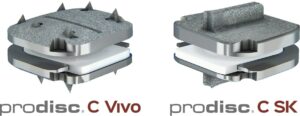
Replacing or relieving damaged or diseased discs with motion-preserving implants offers an alternative to fusion surgery and aims to strike a balance between spine stability and flexibility.
“The spine’s essential function lies in its range of motion,” said Todd Alamin, M.D., Co-Founder and Medical Director of Empirical Spine. “When the spine’s structure deteriorates and poses a risk to the nerve roots, surgeons must alleviate pressure on the nerves while simultaneously addressing underlying instability concerns.”
Engaging in physical activities that subject the spine to shifts, rotations and load force can worsen instability, leading to significant problems. Traditional fusion surgery often restores stability at the expense of flexibility, resulting in functional limitations. The lack of natural motion at the fused segment could also place stress on adjacent areas of the spine, causing further issues.
In appropriately selected patients, motion-preserving implants can offer real benefits, including immediate pain relief and the maintenance of natural spinal movement, factors that can potentially reduce the risk of adjacent segment disease.
With new motion preservation devices entering the market annually, spine companies are actively developing improved solutions that support vertebrae while maintaining some level of flexibility between segments.
“The market is ripe for disruption,” said Ron Sacher, CEO of Premia Spine. “Spine companies are challenged to create new clinical paradigms that provide meaningfully better outcomes.”
Gaining market share might require developing completely new technologies that require expensive and lengthy product development and clinical validation processes. But the efforts have the potential to pay off in a big way.
“The clinical and financial rewards,” Sacher said, “could be enormous.”
Considering the Complexities
Comparing motion-preserving implants and traditional fusion surgery isn’t a straightforward endeavor, and spine surgery isn’t a one-size-fits-all proposition. Dr. Alamin said that surgeons must consider various factors when choosing the right approach for patients with different spinal conditions. The key question is whether a motion-preserving implant suits the patient’s pathology and provides lasting benefits.
“Surgeons determine whether patients will benefit from maintaining motion at the spinal segment,” Sacher said. “For instance, a patient with advanced degeneration of the facet joints and a bone-on-bone disc will gain little from motion preservation, and risks experiencing only minor improvements in function and pain.”
This patient should be fused, according to Sacher. Conversely, he said, a patient with spinal stenosis and spondylolisthesis with a well-functioning disc can achieve significant pain relief and functional improvement from posterior surgical decompression and placement of an artificial motion-preserving facet joint.
Fusion is employed for various reasons, including to address biomechanical challenges and manage conditions like spondylolisthesis and degenerative disc disease. Each instability problem is unique, requiring customized treatment approaches.
According to Dr. Alamin, approximately half of lumbar fusions are performed for degenerative spondylolisthesis. Isthmic spondylolisthesis, scoliosis and fractures present unique mechanical concerns. Additionally, he said, it’s often difficult to determine how to best treat discogenic pain stemming from degenerative arthritis within the disc space.
“It’s important to acknowledge that no single device can cater to these various and complex conditions,” Dr. Alamin added. “Each instability problem is distinct, requiring tailored treatment approaches to yield optimal outcomes.”
Empirical Spine’s LimiFlex Dynamic Sagittal Tether, for instance, offers a minimally invasive, motion-preserving option for degenerative spondylolisthesis patients. The device’s innovative design allows surgeons to perform direct decompressions, relieve nerve pressure and use the LimiFlex implant — two titanium springs connected by a polyethylene strap — to optimize facet joint engagement and preserve the spine’s motion.
“It’s a straightforward tool to use and allows surgeons to perform direct decompressions that alleviate pressure on nerve roots,” Dr. Alamin said. “After the decompression, the LimiFlex implant is strategically positioned around the posterior elements of the vertebrae to serve as a tension band around the decompressed segment.”
Research conducted by Empirical Spine demonstrated the superiority of LimiFlex — lower reoperation rates and improved disability scores — over a standard decompression and transforaminal lumbar interbody fusion (TLIF) procedure at two years post-op. These results were maintained for up to four years in a subset of patients.
LimiFlex also reduces the need for intraoperative fluoroscopy and avoids interbody grafts and screw/rod fixation, making the procedure less invasive. About one-third of the cases involving the device have been performed in ambulatory surgery centers, with none of the patients needing hospital readmission due to complications, according to Dr. Alamin.
Finding Tailored Solutions
The development of motion-preserving implants parallels the advancement of hip and knee replacements, which evolved from bone fusions that robbed patients of motion in their joints to procedures that allow patients to return to routine life activities in weeks instead of months.
Spine surgery is undergoing a similar transformation, according to Sacher. He compared Premia Spine’s TOPS Facet Replacement System to performing a motion-preserving hip or knee replacement. “Instead of fusing lumbar spine segments, and potentially exposing patients to higher risks of adjacent segment breakdown, surgeons can stabilize and maintain normal motion at the index level,” he explained.

Premia Spine’s TOPS system provides mobility and stability in the lumbar spine.
In June, the TOPS system received FDA Premarket Approval with a superior-to-fusion label, reportedly the first lumbar spine implant to receive the designation. Premia Spine conducted an Investigational Device Exemption (IDE) study to confirm the system’s safety and efficacy.
“The results of the IDE study validated that TOPS lumbar facet arthroplasty yields a higher rate of clinical success and fewer revision procedures compared to fusion at two years post-op,” Sacher said.
Results from the study showed that the TOPS system was clinically superior to lumbar fusion in treating grade 1 degenerative spondylolisthesis with stenosis. TOPS performed better in several major clinical markers: TOPS patients had fewer reoperations or injection treatments (a success rate of 89% versus 77%); they experienced a significant improvement in daily function (95% versus 79%); and they had no new or worsening neurologic deficit (97% versus 88%).
TOPS features two cross bars that affix to pedicle screws and a central motion mechanism that stabilizes spondylolisthesis and preserves motion in all ranges of motion. It’s reportedly the only facet joint replacement system on the market that preserves mobility in the lumbar spine after decompression surgery in patients who suffer from spinal stenosis and degenerative spondylolisthesis.
“TOPS maintains flexion, extension rotation, lateral bending and sagittal translation,” Sacher said. “In layman’s terms, the device allows patients to twist, bend, stand straight up and turn as they would normally. Further, TOPS patients heal faster and remain in better form for longer than they would if their spine was fused.”
Research has backed motion preservation as a viable — and potentially superior — alternative to fusion. “When you immobilize part of the spinal column that’s meant to move, shear and stress get offloaded to adjacent areas,” said Steve Murray, CEO of Centinel Spine. “That can cause continual disc degeneration and increase the likelihood of additional surgery.”
Centinel Spine’s market research suggests that only 15% of the patients who are candidates for motion-preserving implants in the cervical spine undergo disc replacement surgery. That rate drops to less than 5% in patients who would benefit from motion-preserving surgery in the lumbar region.
“Our goal is to get patients back to the optimal range of motion with a disc replacement,” Murray said. “We want to return patients to a high level of function, so they resume normal life activities without pain, whether that’s tying their shoes or playing a round of golf.”

Centinel Spine designed the prodisc C Vivo and C SK implants to help patients return to normal life activities.
Murray said that Centinel Spine’s prodisc total disc replacement system features a diverse range of anatomic designs built on a fixed center of rotation that can be tailored to accommodate an individual patient’s distinct anatomy. The company’s latest additions to the system, namely the prodisc C Vivo (featuring a domed design with a spiked endplate) and prodisc C SK (characterized by a flat, short-keeled endplate), offer surgeons the flexibility to opt for the most suitable implant that aligns with the patient’s anatomy, either before or during surgery.
Additionally, prodisc is FDA-approved for cervical and lumbar spine applications, offering a multitude of fitting options for individual patients. The cohesive nature of the system allows surgeons to use the implant that aligns with the patient’s anatomical requirements.
”Our focus lies in enhancing surgical efficiencies within the operating room,” said Steve Sanderson, Vice President of Marketing and Product Development at Centinel Spine. “This entails minimizing the exchange of instruments, which could potentially make for a longer case. Our approach also reduces the extent of bone manipulation that surgeons typically need to perform, reducing the necessity for intricate adjustments to accommodate the implant.
”By affording the flexibility to deploy diverse implants that seamlessly align with each patient’s unique anatomy, we effectively streamline the surgical process, thereby reducing the amount of bone work required,” he added.
Centinel Spine enjoyed record-setting revenue growth and profits in the second quarter of 2023, thanks in part to $17.5 million in worldwide sales of the prodisc system — the highest ever for the company, a 64% growth over the second quarter of 2022 and sequential growth of 24% over the first quarter of 2023. It marked the first time Centinel Spine achieved an EBITA-positive quarter since acquiring the technology from DePuy Synthes in 2017.
The company attributed the overall growth to the U.S. and global releases of the prodisc C Vivo and prodisc C SK in September 2022 and the expansion of the prodisc lumbar total disc replacement business. Nearly 800 procedures were performed with the C Vivo and C SK systems in the second quarter of 2023, driven by a 50% increase in average surgeon users versus the previous quarter.
The Push for Personalized Care
The advent and employment of motion-preserving spine implants signify a shift toward solutions that focus on tailoring treatments to an individual patient’s unique spinal condition. Traditional fusion surgery is gradually giving way to evidence-based disc replacements as enabling technology is poised to reshape the spine landscape, Sacher said.
Advancements in preoperative planning software and navigation systems — and increased access to and adoption of the tech — will significantly benefit patients undergoing spine surgery. Murray said that surgeons could leverage the technology to conduct comprehensive preoperative planning and tailor implants to the exact anatomical needs of individual patients, a transformation that echoes the evolution seen in knee and hip replacement.
The evolving spine market also underlines the importance of patient empowerment and education. Informed patients are now actively engaging with their healthcare providers and seeking treatment options beyond traditional solutions like fusion.
Patients are sharing success stories after undergoing disc replacement surgery, leading to a shift in patient expectations and demands. This places greater emphasis on the further refinement and expansion of motion-preserving technology that gives surgeons a wider array of tools at their disposal.
“Standard fusion techniques lack disease-specific precision,” Dr. Alamin said. “I believe that the future lies in tailoring treatments to address specific spine diseases. This approach will hopefully mitigate the drawbacks associated with spinal instrumentation, allowing for greater efficiency in procedures. Surgeons can achieve a higher level of precision, ultimately leading to improved patient care and outcomes — a goal that resonates with all of us in the field.”
KK
Kendal Kloiber is a contributing editor.




